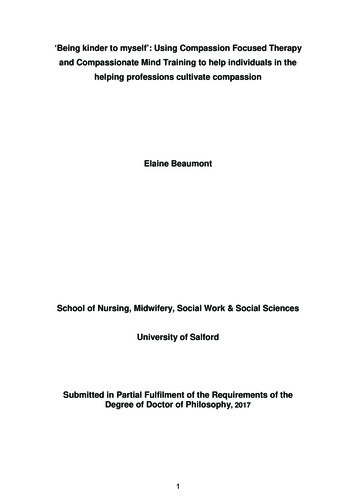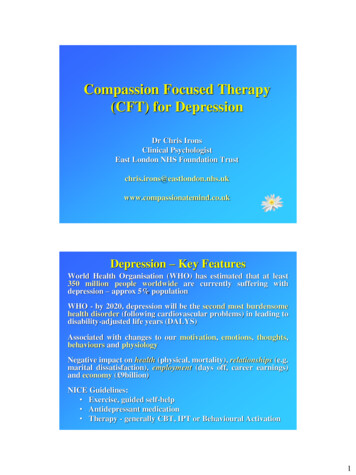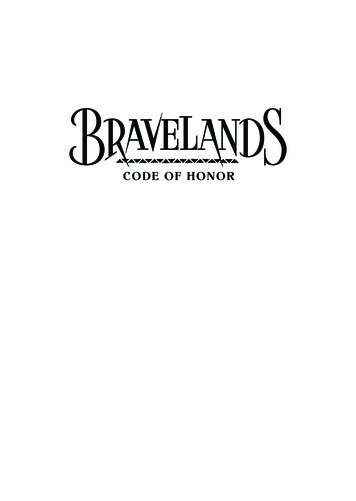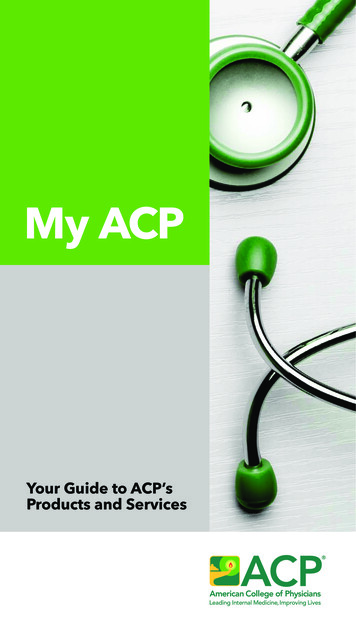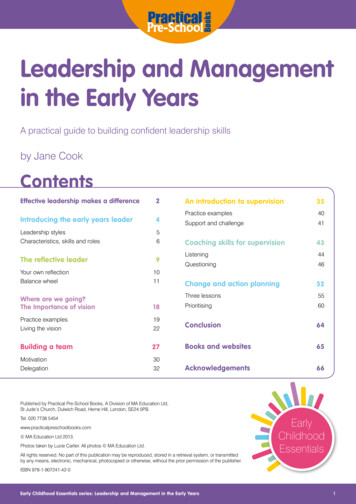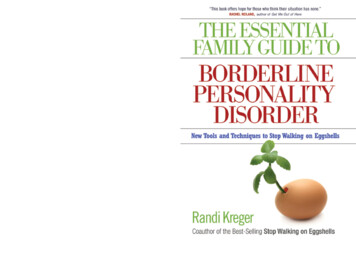
Transcription
“This indispensable book is compassionate to all involved and avoidsblame, jargon, and oversimplification.”Freda B. Friedman, PhDDialectical Behavior Specialist“With exquisite understanding of the disorder and empathy for boththose who have it and their family members, Randi Kreger offers valuable‘Power Tools’ to help readers endure the ravages of BPD.”Jerold J. Kreisman, MD, coauthor of I Hate You—Don’t Leave Me:Understanding the Borderline Personality and Sometimes I ActCrazy: Living with Borderline Personality Disorder“Randi Kreger uncovers the marvelous symmetry of the borderline relationship, in which both participants experience similar self-doubts,irrational guilt and shame, wavering identity, helplessness, anger, andfear of abandonment. Those with BPD and their loved ones will, together,benefit from the tools she provides.”Richard A. Moskovitz, MD, author of Lost in the Mirror:An Inside Look at Borderline Personality Disorder“Randi Kreger masterfully breaks down BPD to help people more easilyunderstand this complex subject.”Barbara Oakley, PhD, author of Evil Genes: Why Rome Fell,Hitler Rose, Enron Failed, and My Sister Stole My Mother’s Boyfriend
The Essential Family Guide toBorderline Personality DisorderNew Tools and Techniquesto Stop Walking on EggshellspRandi Kregerp
HazeldenCenter City, Minnesota 55012hazelden.org 2008 by Randi KregerAll rights reserved. Published 2008Printed in the United States of AmericaNo part of this publication may be reproduced, stored in a retrieval system, or transmitted in any form or by any means—electronic, mechanical, photo copying, recording, scanning, or otherwise—without the express written permission of the publisher.Failure to comply with these terms may expose you to legal action and damages forcopyright infringement.Library of Congress Cataloging-in-Publication DataKreger, Randi. The essential family guide to borderline personality disorder: new tools and techniques to stop walking on eggshells / Randi Kreger.p. cm.Includes bibliographical references and index.ISBN 978-1-59285-363-2 (softcover)1. Borderline personality disorder—Treatment. 2. Borderline personality disorder—Patients—Family relationships. 3. Antisocial personality disorders—Treatment. I. Title.RC569.5.B67K73838 2008616.85'852—dc222008036456Editor’s noteThe BPD stories quoted in this book are either composites or used with permission.In some instances, names, details, and circumstances have been changed to protectanonymity.This publication is not intended as a substitute for the advice of health careprofessionals.12 11 10 09 08 1 2 3 4 5 6Cover design by Theresa Jaeger GedigInterior design by Ann SudmeierTypesetting by BookMobile Design and Publishing Services
DedicationThis book is for those who walked with me hand in hand—and sometimes carried me—in my own journey along the yellow brick road. It isalso dedicated to the libraries in and around Saint Louis Park, Minnesota.The children’s novels there, more precious than any ruby-red slippers,made both me and this book possible.
When we are no longer ableto change a situation . . .we are challenged to change ourselves.p Viktor E. Frankl p
ContentsForeword by Robert O. Friedel, MDAcknowledgments p xvAbout This Bookppxi1Part 1: The ABCs of BPDChapter 1: Welcome to Oz p 7Chapter 2: Understanding Borderline Personality DisorderChapter 3: Making Sense of Your Relationship p 49Chapter 4: Risk Factors of BPD p 67Chapter 5: Treating BPD p 79Chapter 6: Finding Professional Help p 97p23Part 2: Power ToolsAbout Power Tools p 125Chapter 7: Power Tool 1: Take Good Care of Yourself p 129Chapter 8: Power Tool 2: Uncover What Keeps You Feeling StuckChapter 9: Power Tool 3: Communicate to Be Heard p 163Chapter 10: Power Tool 4: Set Limits with Love p 195Chapter 11: Power Tool 5: Reinforce the Right Behavior p 227Conclusion: Start TodayResources p 243Notes p 255Index p 267About the Authorppp147241275ix
ForewordThe Essential Family Guide to Borderline Personality Disorder is a very useful addition to the growing literature on borderline disorder (the term mostacceptable to my patients and readers). The author’s first book, Stop Walkingon Eggshells (with Paul T. Mason), has been an international best seller in thisfield since its publication in 1998. A brief overview of the history and currentstatus of borderline disorder will provide context for this guide.Borderline disorder has been surrounded by many myths that leavepeople with the disorder and their family members feeling very hopeless.This should not be so because there are many actions that can be taken tomarkedly reduce the effects of borderline disorder on those who have itand on their families.For almost a century, borderline disorder has been referred to as a“wastebasket diagnosis,” reserved for those patients whose presentingsymptoms are often so complex that they do not fall cleanly into a singlediagnosis, thereby frustrating the clinician, the patient, and the family.Borderline disorder is resistant to treatment with conventional uses oftraditional treatment approaches, and it was not listed in the AmericanPsychiatric Association’s Diagnostic and Statistical Manual of Mental Disorders until 1980. According to the latest research, this devastating disorderhas an estimated prevalence of almost 6 percent in the general population.The many years of neglect of borderline disorder have resulted in a highprevalence of underdiagnosis, disability, continued suffering, prematurexi
xiiForeworddeath by suicide, and a deep sense of hopelessness. These overwhelmingemotions pervade not only those with the disorder, but also their familymembers, whose lives are terribly affected. In short, borderline disorder isan overlooked, devastating disorder of tragic proportions.Today, however, there is new hope as a convergence of factors are causing dramatic strides forward. The first factor is represented, in part, by thereports of neuroimaging studies that demonstrate clear differences in thebrains of people with borderline disorder compared with those of control subjects. Other studies have demonstrated a high degree of heritability of borderline disorder, further underscoring the fact that the disorderhas a significant biological basis. These studies provide clear and visibleevidence that borderline disorder is associated with anatomical and functional abnormalities of the brain, and that the disorder should be viewedno differently than medical disorders affecting other organs.The second factor is the emergence of research on the effective useof a new generation of antipsychotic agents, antidepressants, mood stabilizers, and psychotherapeutic and psychosocial interventions specificallydeveloped for borderline disorder. Treatment programs have also been significantly effective for patients with the disorder, and they have providedhighly useful information and new skills to patients’ families.The third factor has been the development of two national advocacyorganizations focused solely on borderline disorder: the Treatment andResearch Advancements National Association for Personality Disorder(TARA APD) and the National Education Alliance for Borderline Personality Disorder (NEA-BPD). These organizations are dedicated to educating patients and their families about the disorder and how to cope moreeffectively with it.The other mission of these organizations is to increase awareness of thedisorder on a national and even international level and stimulate publicand private funding for research and education. As a result of the efforts ofthe leadership of NEA-BPD, people with borderline disorder, their families, and professional experts in the field, the U.S. House of Representativespassed a resolution (H. Res. 1005) on April 1, 2008, designating the monthof May as Borderline Personality Disorder Awareness Month.
ForewordxiiiIn addition, other organizations have added significantly to the increase in activity in the field. For example, the National Alliance on Mental Illness (NAMI) has recently named those with borderline disorder asone of their “priority populations.” The Borderline Personality DisorderResource Center has been recently established to help those affected byborderline disorder “find the most current and accurate information onthe nature of BPD, and on sources of available treatment.”Two new important private resources for research funding of borderline disorder have begun to have a positive effect on the field. Founded in1999, the Borderline Personality Disorder Research Foundation (BPDRF)“has mobilized research centers in the United States and Europe to investigate whether BPD is a recognizable distinct entity, and, if so, whatthe defining characteristics of the disorder are.” Initially, it selected andfunded four centers to investigate borderline disorder from varying scientific and clinical perspectives. In addition, it has awarded research grantsto twenty-two investigators.During the past decade, the National Alliance for Research on Schizophrenia and Depression (NARSAD) has expanded its original focus fromschizophrenia and affective disorders to other prevalent mental disorderssuch as anxiety disorders. Since 1987, this donor-funded organization hasawarded more than 180 million in grants to senior and new meritoriousresearchers involved in brain research focused on psychiatric disorders.Recently, it has included borderline disorder in its areas of interest.A final critical factor has been the marked increase in the amount ofinformation readily available about borderline disorder. During the pastdecade there has been an increasing number of books written for the nonprofessional about borderline disorder, and there has also been a comparable number of Web sites launched. One of the most successful of thesebooks has been Stop Walking on Eggshells, coauthored by Randi Kreger,the author of this guide.In Stop Walking on Eggshells, Kreger focused her attention on the families of those who do not acknowledge their borderline disorder, do notseek treatment, and blame their difficulties on others. The success of thisbook attests to the large number of people who fall into this group—whom
xivForewordKreger calls “higher-functioning invisible BPs” in this book—and the devastating effect their behavior has on their families and others close to them.In The Essential Family Guide to Borderline Personality Disorder, Kregersignificantly expands the scope of Stop Walking on Eggshells and her accompanying workbook by providing a current and understandable description of the symptoms, nature, and treatment of the disorder by usingnumerous helpful examples. She also provides much useful advice to families on how to effectively help and how to cope with a family member withborderline disorder.To do so, Kreger has read broadly in the area and has consulted witha number of leading experts to ensure, to the highest degree possible, theaccuracy of her content. This represents no small amount of investigativework, as scientific knowledge in the field is expanding rapidly.In The Essential Family Guide to Borderline Personality Disorder, Kregerutilizes a markedly different approach to educate her readers. Using novelconcepts and approaches, she integrates a comprehensive amount of information about the disorder and its treatment.Kreger does so in a writing style that neither “talks down” to the readernor expects a high level of knowledge of psychology and neuroscience.Kreger achieves her formidable task in a very impressive fashion. In TheEssential Family Guide to Borderline Personality Disorder, there is much tobe learned by family members who are affected by loved ones with borderline disorder, and also by professionals who strive to help them.Robert O. Friedel, MDDistinguished Clinical Professor of PsychiatryDirector, Borderline Personality Disorder ProgramDepartment of Psychiatry, Virginia Commonwealth UniversityRichmond, VirginiaAuthor, Borderline Personality Disorder Demystifiedwww.bpddemystified.com
AcknowledgmentsWhen someone asked a songwriter I know how long it took her to compose a song, she said, “my whole life.” In the same way, this booktook my whole life—the years I spent in my own BP/non-BP relationship, the dozen years I spent managing my online community for family members, and the three years of intensive research and writing thatwent into this particular book, the third of my trio of books for those whoare struggling to love someone who keeps painfully pushing them away.On the publishing side, the heavy lifting was done by my good friendand literary agent Scott Edelstein and former Hazelden editor Rebecca Post.Few agents provide the hand-holding and “rah-rahing” that Scott does, andno one else could have been such an excellent sounding board. He has beenwith me from that day in the early 1990s when he said, “So, do you thinkyou’re ever going to do that book on borderline personality disorder?”Rebecca Post actually initiated this book when she asked me whetherI was interested in writing something for Hazelden—a memoir, perhaps.That seed of an idea grew into the book you now hold in your hands. Shenurtured this book in a way that few editors do today. Sid Farrar and thestaff at Hazelden stepped in after Rebecca left and have been positive forcesin shaping the manuscript, ensuring accuracy, and promoting the book toa wide audience.Because of the success of my previous books, Stop Walking on Eggshellsand The Stop Walking on Eggshells Workbook, I had access to some of thexv
xviAcknowledgmentstop BPD clinicians, researchers, advocates, and other professionals whenwriting this book. They all share my passion for helping those with thisinsidious disorder and for helping their friends and family.At the topmost level is Robert O. Friedel, MD, Distinguished ClinicalProfessor of Psychiatry at Virginia Commonwealth University and the author of Borderline Personality Disorder Demystified. He kindly wrote theforeword and spent hours teaching me how impairments of the physicaland chemical brain can lead to BPD behaviors. He also lent his insights tothe chapters on treatment and finding a clinician. Thank you.Another important contributor is Blaise Aguirre, MD, the medical director of the Adolescent Dialectical Behavioral Therapy Center atMcLean Hospital in Belmont, Massachusetts. He is a child-and-adolescentpsychiatrist recognized for his work in the treatment of BPD and is theauthor of Borderline Personality Disorder in Adolescents. Dr. Aguirre managed to do interviews with me despite his hectic schedule, sometimes fitting me in by cell phone as he walked through the hospital corridors. If youare the parent of a borderline child, you need his book.Jim Breiling, PhD, from the National Institute of Mental Health, is theclinical cornerstone of all things BPD—a kind of real-life “BPDCentral.” Hehas been supportive of my work for many years and answered a multitudeof questions during the time we’ve worked together. He is the greatest.Other clinicians and professionals who gave me in-depth interviews orsignificant content include the following (in no particular order): Beverly Engel, MFCT, a psychotherapist and the author of eighteen self-help books.p Barbara Oakley, author of Evil Genes: Why Rome Fell, HitlerRose, Enron Failed, and My Sister Stole My Mother’s Boyfriend.At the last minute, I asked Barbara to apply first aid to thebrain chemistry section in chapter 4. She assisted me in writing it and came up with the analogy of tree pollen.p John Gunderson, MD, Professor of Psychiatry at HarvardMedical School and Director of Psychosocial and Personalityp
AcknowledgmentsxviiResearch at McLean Hospital in Belmont, Massachusetts, andCynthia Berkowitz, MD.p Sharon, founder of the online community NUTS (parentsNeeding Understanding, Tenderness, and Support to help theirchild with borderline personality disorder).p Perry D. Hoffman, President of the National Education Alliancefor Borderline Personality Disorder and cofounder of the FamilyConnections Program.p Floyd Koenig, who served as an impromptu research assistant,gathering information on topics at my request.p A. J. Mahari, a recovered individual with BPD who hasauthored several electronic books and maintains the Web siteBorderline Personality Disorder from the Inside Out(www.borderlinepersonality.ca).p Debra Resnick, PsyD, President of Psychological Services andHuman Development Center, Inc., in Fort Washington, Penn sylvania. Debra, a psychotherapist who specializes in dialecticalbehavior therapy (DBT), uses my workbook in a great deal ofher work with families.Furthermore, I am honored that these leading clinicians known for theirwork with individuals with BPD reviewed chapters of this book for accuracy(although I take all responsibility for the content). These notable people are Robert O. Friedel, MD: chapters 1–6p Marlene Schwartz, RN, MSN, PhD, ANCC, APNP: chapter 8p(Power Tool 2: Uncover What Keeps You Feeling Stuck)p Debra Resnick, PsyD: chapter 9 (Power Tool 3: Communicate toBe Heard)p Freda Friedman, PhD (DBT psychotherapist and coauthor ofSurviving a Borderline Parent): chapter 10 (Power Tool 4: SetLimits with Love)p Blaise Aguirre, MD: chapter 11 (Power Tool 5: Reinforce theRight Behavior)
xviiiAcknowledgmentsOther professionals whom I interviewed or whose work inspired me include Byron Bloemer, PhD; Annette Boehm; Andrea Corn, PsyD; CarolynDeRoo; William Eddy, attorney, mediator, and clinical social worker;Kathryn Jane Gardner, PhD; Mary Gay, PhD, LPC; Jan Hargrave; andJames Holifield, LCSW.Also Patricia A. Judd, PhD; Anne Katherine, MA, CEDS; Janet Klosko,PhD; L. Allison Langlois, PsyD; Daniel Mattila, MDiv, LCSW; BennettPologe, PhD; Karen Pryor; Rachel Reiland; Kimberlee Roth; Kwan Soo,MD; and Amy Sutherland. The founding mothers of the fundamentalpremise of all three of my books have been Harriet Lerner, PhD, andher book The Dance of Anger, and Susan Forward, PhD, and her bookEmotional Blackmail.I would also like to thank two singer-songwriters for the use of theirlyrics: John Forster (“Codependent With You,” page 158) and CarrieNewcomer (“Closer to Home,” page 242). I found Carrie’s lyric about going“to the edge of my blindness, and then a little more ways” to be a perfectdefinition for a leap of faith.All writers have something we must deal with called “real life,” whichoccurs in those brief moments when we’re not stewing about the book,researching the book, writing the book, rewriting the book, or incessantlytalking about the book until everyone around us becomes thoroughly sickof hearing about it. My husband, Robert, has kept me fed these past threeyears (twelve years, if you count the first two books) and seen to things likechanging the oil in my car while I had my nose in a book, was staring atmy computer, or looking blankly at nothing while my mind was churningout the solutions in the second half of this book. He is the one who avidlyscans the Internet and sends me new book reviews, articles, and the URLsof Web sites he thinks I might be interested in.Lisa Radtke, the manager of my Welcome to Oz (WTO) online family community, took over after the death of a dearly beloved volunteerand has, for the past several years, kept the WTO community a safe,sacred place for all 16,000 members in fifteen Listserv “neighborhoods.”Assisting Lisa is another longtime volunteer, Rita Closson, MA, who scans
Acknowledgmentsxixthe list and sounds the alert when something needs attention. Rita missedher true calling as a stand-up comedian.In 2007, computer programming whiz kid Robert Bauer tried to help mekeep my technically challenged message board on www.bpdcentral.com inone piece. When it became apparent that, like the Titanic, it was sinkingfast and all I could do was rearrange deck chairs, he gave the messageboard new life at his “Facing the Facts” board at www.bpdfamily.com. Hehas been generous with his time and expertise in all sorts of matters.Also in 2007, Leslie Steis assisted me by setting up interviews anddoing research. I learned a great deal from her about the challenges facinggrandparents, who are so often villainized and prevented from spendingtime with their beloved grandchildren.Finally, I would like to recognize Edith Cracchiolo, a good friend whomI sorely miss. She and I worked together on the WTO community for tenyears. For several of them, she dedicated more than eight hours a day toassisting people on the WTO, especially her beloved adult children. In2005, she traded in her earthly guardian angel wings for real ones up inheaven. How I wish she were here so I could give her this book. She wouldhave taken it in both hands, looked up at me with a grin, and exclaimed,“Yes!”The author gratefully acknowledges the following sources:Kay and Doug’s story, pages 11–13, reprinted with permission from Hopefor Parents: Helping Your Borderline Son or Daughter Without SacrificingYour Family or Yourself by K. Winkler and R. Kreger (Milwaukee, WI:Eggshells Press, 2000). Richard and Laurie’s story, pages 13–15, reprintedwith permission from Love and Loathing: Protecting Your Mental Healthand Legal Rights When Your Partner Has Borderline Personality Disorderby R. Kreger and K. Williams-Justesen (Milwaukee, WI: Eggshells Press,2000). All material from A. J. Mahari’s Web site articles reprinted withpermission of the author. Material from June People’s radio interview reprinted with permission of The Infinite Mind produced by LCMedia, Inc., 1999. Material on schema therapy reprinted with permission of Jeffrey E.
xxAcknowledgmentsYoung from www.schematherapy.com—this material also appears inSchema Therapy: A Practitioner’s Guide by Jeffrey E. Young, Janet S. Klosko,and Marjorie E. Weishaar (New York: Guilford Press, 2003). Material onmedications for mental health conditions, page 80, taken from www.drjoecarever.com, “The Chemical Imbalance in Mental Health Problems,” byJoseph Carver, PhD, reprinted with permission. Medication chart, pages81–82, taken from www.bpddemystified.com, reprinted with permission ofRobert O. Friedel, MD. E-mail from Rachel Reiland, pages 101–102, reprintedwith permission of Rachel Reiland. Material on the Stockholm Syndrome,page 149–150, taken from www.drjoecarver.com, “Love and StockholmSyndrome: The Mystery of Loving an Abuser,” by Joseph Carver, PhD,reprinted with permission. Material from www.aboutpsychotherapy.comreprinted with permission of Bennett Pologe, PhD. Material from theNational Association of Cognitive-Behavioral Therapists Web site (www.nacbt.org) reprinted with permission. “Codependent With You” musicand lyrics by John Forster, page 158, 1991 Limousine Music Co. (ASCAP),all rights reserved, reprinted with permission. Chart on boundaries, page199, reprinted with permission of Donna Bellafiore, www.drbalternatives.com, by Simmonds Publications. “To the edge of my blindness, and thena little more ways,” lyric adapted with permission on page 242, from Closerto Home, lyrics by Carrie Newcomer.
About This BookThe information in this book reflects the best of three types of research:an exhaustive, three- year survey of the latest scientific studies relatedto border line personality disorder (BPD), interviews with more than twodozen top mental health clinicians and researchers, and the collective experiences of thousands of people affected in one way or another by BPD.All these individuals are members of the Welcome to Oz Online FamilyCommunity located at bpdcentral.com or the Facing the Facts messageboard at www.bpdfamily.com.Welcome to Oz, or WTO, has provided an online home for more than65,000 family members since it started in 1996. It functions much like areal- life support group, except that members communicate via e-mail instead of face- to- face. Current membership stands at 16,000, with membersgathering by type of relationship (parents, siblings, stepparents) or similarities in their situations (partners who want to stay in the relationshipsversus those who have decided to separate). Facing the Facts—with 7,000members—offers the same support. There, members post their thoughtson an online message board.In part 1 of this book, you’ll learn exactly how BPD impairs an individual’s thoughts and feelings, which in turn triggers behaviors such asraging, perceived manipulation, suicide threats, and excessive blame andcriticism. Since the bane of every family member is finding effective professional help, chapter 6 provides hard and soft qualities to look for in aclinician and seven questions that separate neophyte BPD providers fromthose with the necessary experience.1
2About This BookThen, armed with new insight about how your border line family member experiences the world, you’ll be introduced to five powerful tools thatwill help you organize your thinking, learn specific skills, and focus onwhat you need to do to avoid becoming overwhelmed. They will help youbecome more confident and clear about who you are, and they will showyou steps to take to improve the quality of your life.Many self- help books are written so readers can skip from chapterto chapter as needed. This book isn’t one of them. The chapters in TheEssential Family Guide to Border line Personality Disorder are like Russiandolls— you open a big doll, and inside there’s a smaller doll, and insidethat a smaller one, and so on. Many of the concepts and terms used areunique to this book. So, start at the beginning and read straight through.The one exception is the chapter on finding a therapist.If you feel trapped, this book will teach you how to get unstuck. If youfeel burdened, you’ll learn how to ask for help from others. If your self esteem is in the pits, you’ll learn how to climb up, step by step. And perhapsmost important, you’ll come to realize that you have a right to your ownfeelings and your own beliefs, and the right to pursue your own goals.Psychiatrist Milton Erickson said, “There are so many things youknow. It’s just that you haven’t always known that you know them.” Afteryou’re done reading this book, you’ll know.Terms You Need to KnowTo keep it simple, we use the following terms throughout this book.“Border line” and “BP”Because the diagnosis of border line personality disorder (BPD) has beenso stigmatized, it’s much more acceptable to say, “He’s bipolar” or “She’sa diabetic” than to say, “He’s border line.” In effect, there is a double standard. Just the word border line conjures up such negative stereotypes thatmany people avoid the term altogether or use a substitute.One popular alternative is consumer, as in consumer of the mentalhealth system. However, a large percentage of people with BPD are not in
About This Book3the mental health system. They are in as much denial of their illness as anactive, untreated alcoholic. They not only don’t seek treatment, but alsoforcefully repel any suggestion to do so.People with BPD are finding their own solution. Just as people whoare gay or lesbian have adopted the word queer as their own, individualswith BPD use the term border line or BP for short. This book will followtheir lead.“Family Member” and “Non- BP”A similar problem surrounds the term family member. Like the term consumer, family member is limited. The effects of BPD are far- reaching: inaddition to the immediate family, the disorder impacts the lives of extended relatives, co- workers, friends, in- laws, stepparents, those who emotionally support family members, and even therapists. For this reason, theterm non- BP refers to anyone who is in a situation in which the behaviorof a BP affects him or her.Non-BPs may have their own mental health issues, too, from depression to a personality disorder. In fact, it’s common for some non-BPs tohave either BPD or narcissistic personality disorder (NPD). You’ll readmore about narcissism on pages 46–47. Stop Walking on Eggshells has anappendix called “Tips for Non-BPs Who Have BPD.”The terms BP and non- BP are not a philosophy meant to divide lovedones and family members into separate camps. They’re just shorthand,like saying “scuba gear” instead of “self- contained underwater breathingapparatus.”
p Part 1 pThe ABCs of BPD
Chapter 1Welcome to OzBe true to yourself despite being misunderstood.It is painful but not fatal.p I Ching pDo you feel as though you’re walking on eggshells around someone important in your life? Does this phrase immediately strike not just achord but a whole piano concerto? If so, someone in your life may haveeither border line personality disorder (BPD) or border line traits.Take a look at the following questions. If you answer “yes” to most ofthem, your loved one might have BPD: Does she see you in one of two modes: either a hateful personwho never loved her or a source of blessed, unconditional love?p Does he continually put you in no- w in situations? When youtry to explain that his position is the opposite of what he saidearlier, does it bring on more criticism?p Is everything always your fault? Are you the target of constantcriticism?p Are there times when everything seems normal and you’re onher good side— even idealized— but then for no obvious reasoneverything falls apart?p When he’s angry, does it degrade into a take- no- prisoners, vicious attack that leaves you reeling?p7
8The ABCs of BPD Does she use fear, obligation, and guilt to get her way? Do youfeel so manipulated that you don’t trust her anymore?p Are you starting to doubt your own sense of reality? Has constant exposure to his skewed sensibility, combined with isolation from family and friends, made you feel like Dorothyconfounded in the strange Land of Oz?pWhat Is Border line Personality Disorder?Border line personality disorder is a serious mental illness that causesthose who have it to see people and situations as all good or all bad; tofeel empty and without an identity; and to have extreme, blink- of- an-
xi The Essential Family Guide to Borderline Personality Disorder is a very use - ful addition to the growing literature on borderline disorder (the term most acceptable to my patients and readers). The author’s first book, Stop Walking on Eggshells (with Paul T. Mason), has been an international

